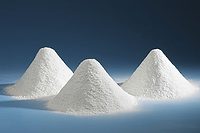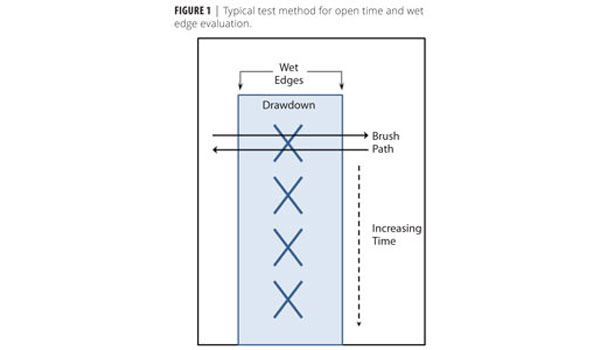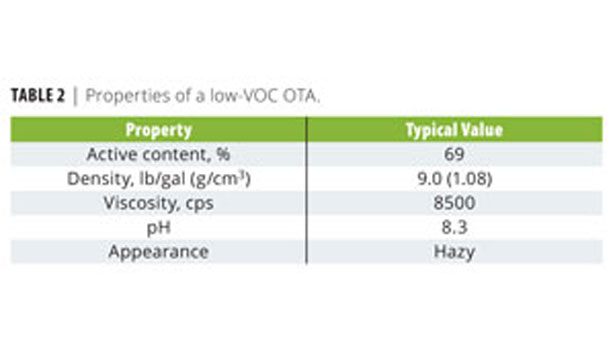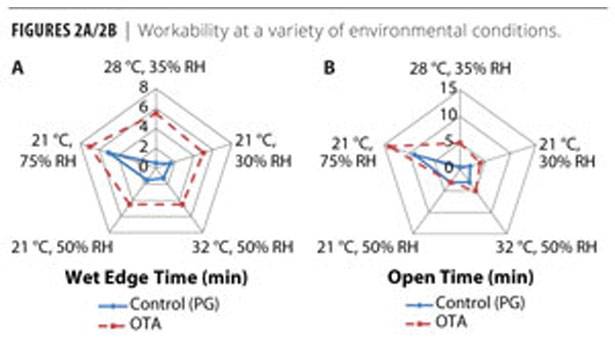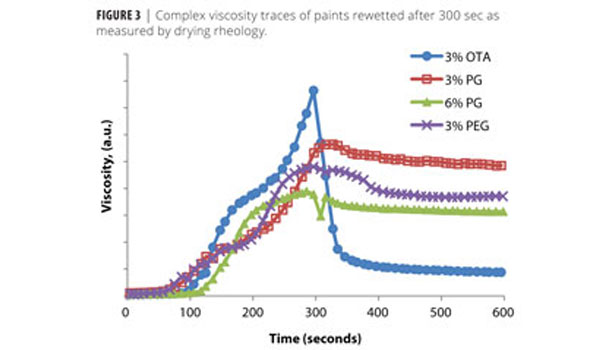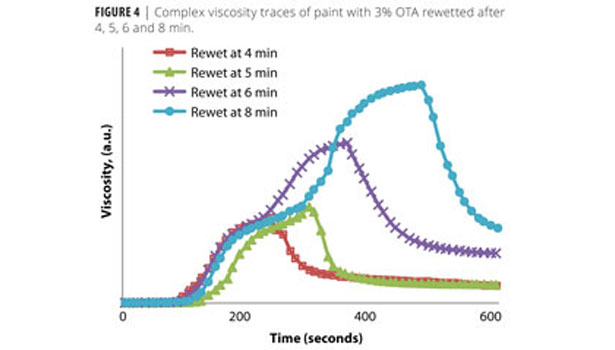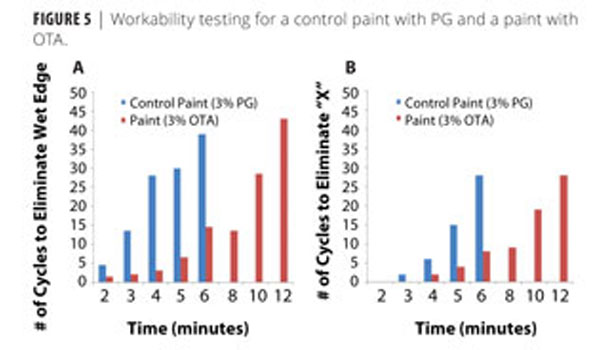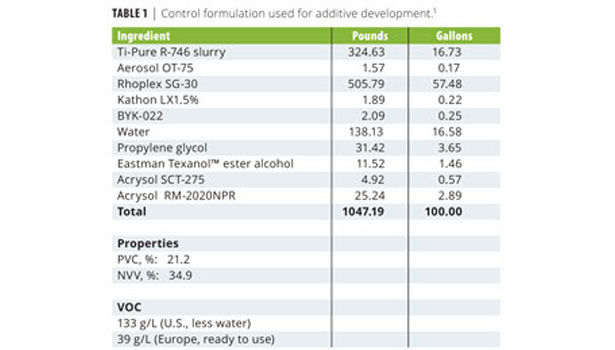Novel Additives to Extend Open Time in Low-VOC Latex Paints
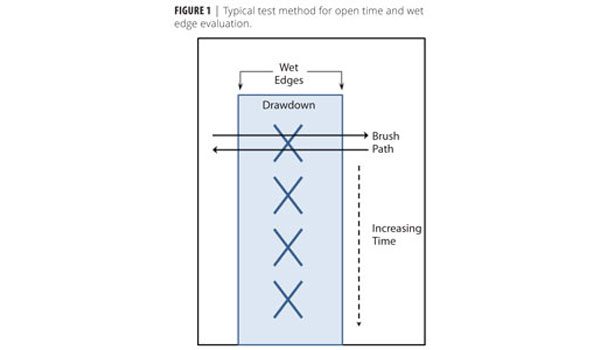
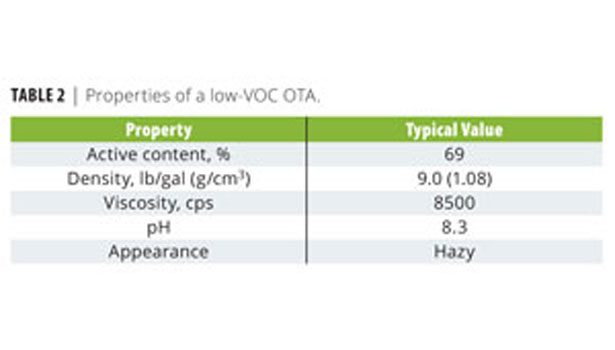
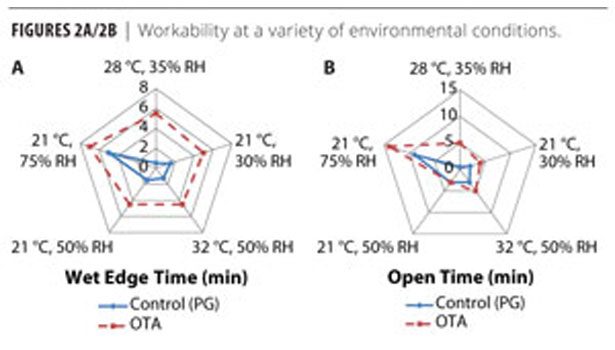
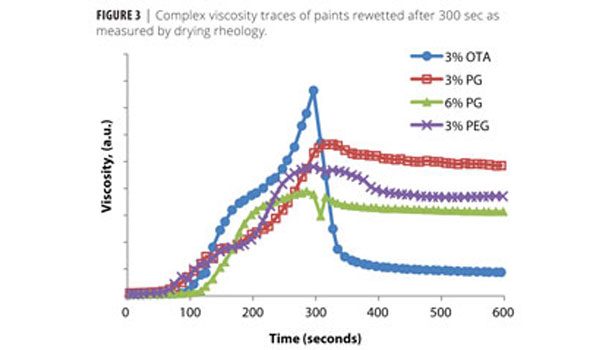












One of the challenges of formulating waterborne architectural coatings is achieving an acceptable balance of properties both during application and in the final film. Over the past decade, this has become increasingly more difficult because of the significant changes in VOC regulations. Although VOC definitions differ from region to region, the propylene and ethylene glycol used to improve open time and wet edge are universally considered to be VOCs. Since glycols are one of the primary VOC sources, they are often reduced or eliminated in lower-VOC paints, thus compromising open time, wet edge and paint workability. This creates the need for a solution that enhances paint workability without contributing significant VOCs and without negatively impacting film properties such as scrub resistance and wet adhesion.
This article describes a new, low-VOC additive that improves open time, wet edge and workability in low-VOC latex paints. Paint performance properties are demonstrated in a typical architectural formulation, and mechanisms for the enhanced performance are outlined through use of novel rheological techniques.
Evaluating Open Time
There are numerous methods to characterize open time and wet edge time. Open time is defined as the period of time during which irregularities in a freshly applied coating can be repaired, while the period in which a coating can be applied over an existing paint film without leaving lap marks is the wet edge time.
One of the most common techniques requires a paint film to be drawn down on a sealed chart with a series of ‘X’ marks in the center of the drawdown. After fixed periods of time, paint is brushed four cycles back and forth across the film. The point at which the edge of the drawdown can no longer be worked into the body of the paint is referred to as the wet edge time, while the time at which the ‘X’ begins to show through the paint is the open time. This method is illustrated in Figure 1.
Development of Low-VOC Additives
This work focused on designing a low-VOC, low-emission additive to improve the wet edge and open time of latex paints without compromising performance. The initial target was to provide performance observed in 150 g/L paints (U.S.) at a reduced VOC of 50 g/L. The work started with the screening of potential materials for impact on open time and wet edge when post-added to a commercial semigloss paint. From this work, a subset of promising, low-VOC materials was identified. Subsequent work was carried out in an acrylic semigloss formulation to allow a more direct comparison of the experimental materials with the propylene glycol. The formulation is presented in Table 1. Using a designed study, an optimized composition was determined for an open time additive (OTA) with a good balance of properties at reduced VOC. The properties of this OTA are defined in Table 2.
Evaluation of Paints Containing a Low-VOC OTA
Performance of paints made with 3% active OTA compares favorably to paints with 3% propylene glycol. Table 3 compares the properties of the two paints. The OTA provides a reasonable balance of properties compared to the higher-VOC control formulation.
Another challenge for waterborne architectural paints is the variation in the workability that is observed at different environmental conditions. Since most of the development work was completed at standard lab conditions, open time and wet edge times were evaluated on both the control and paint containing the OTA at five different temperature/humidity combinations. As expected, the humectant propylene glycol in the control paint provides poor wet edge and open time at higher temperature/low humidity and good wet edge/open time at higher humidity. In contrast, the paint with the OTA provides excellent wet edge time regardless of temperature and humidity. Open times were superior for the lower-VOC paint containing the OTA except at 21 °C and 50% RH, where the results were similar. These results are summarized in Figures 2a and 2b.
Rheological changes during drying can also affect the workability of a latex paint. The short open time and limited window of workability can potentially be correlated with a rapid increase in the viscosity at the edge of an applied coating. A modification of a novel rheology technique developed at Eastman Chemical Company2 was used to define the drying and rewetting behavior of paints compared to wet edge/open time testing. Beginning about 40 seconds after the paint sample was prepared, a dynamic time sweep at a fixed frequency was run. At fixed times, the drying paint was rewetted with a few additional drops of the same paint. This allowed the rewetting behavior of each coating to be quantified. Four coatings based on the formulation from Table 1 were tested. Paints with propylene glycol (PG) at 3% and 6% loadings were compared to paints with 3% of a commercial 400 molecular weight polyethylene glycol (PEG) and 3% actives of the OTA.
Figure 3 provides a comparison of the viscosity build and rewetting behavior of the four paints at 5 min (300 sec). The sample containing 3% OTA builds viscosity rapidly, which may be associated with improved sag resistance, but shows significant rewetting with an 82% reduction in viscosity. The other three paints showed minimal reduction in viscosity upon rewetting (15-20%), suggesting that it is unlikely that these paints had any significant workability remaining. These viscosity traces correspond closely to concurrent open time measurements of 7.5 min open time for the paint with 3% OTA, 5.5 min for the paint with 6% PG, 4 min for the paint with 3% PG, and 3.5 min for the paint with 3% PEG.
Figure 4 shows additional viscosity traces for the paint samples containing 3% OTA, with rewetting after 4, 5, 6 and 8 min. The viscosity prior to rewetting continues to increase with increasing dry time. Beyond 5 min, the viscosity after rewetting continues to increase but, even after 8 min, there is still more than a 60% reduction in viscosity with rewetting. This suggests that the OTA provides improved workability through a unique mechanism beyond that of simply reducing the evaporation rate of the continuous phase.
The rewetting behavior of the control paint with 3% PG and the paint with 3% OTA was further studied using a variant of the open time test method illustrated previously in Figure 1. At each time period, the paints were brushed until the edge could be worked in (up to a maximum of 50 cycles). Figure 5 provides a summary of the results for both the wet edge (a) and open time (b). The paints with 3% PG require more strokes to eliminate the wet edge, and beyond 6 min the edge can no longer be worked in. The wet edge of the paint with 3% OTA can still be worked in after 12 min. Results were similar for the open time testing. Paint formulated with the OTA exhibits typical viscosity development characteristics, but the paint can be rewetted and reworked for a significantly longer time.
Conclusions
A low-VOC additive that improves wet edge and open time of latex paints without compromising paint performance has been developed. This material was identified based on the combination of an initial screening process with more extensive formulation and testing work in conjunction with a large designed experiment. The open time additive provides more robust workability over a range of temperature and humidity as compared to propylene glycol.
A novel rheological technique demonstrated that paint formulated with the open time additive exhibits a typical viscosity increase during the early stage of drying, but was unique in that the paint film would thin back down remarkably upon rewetting with several drops of fresh paint. This rewetting behavior was further examined by open time and wet edge testing in which samples were brushed until the edge or ‘X’ could be eliminated. Paint formulated with propylene glycol could only be reworked for about 5 min, while paint with the open time additive could be rewetted and reworked up to 12 min. The mechanism for this behavior is not fully understood, but the data suggests that the OTA provides improved workability through a unique mechanism beyond that of simply reducing the evaporation rate of the continuous phase.
References
1 Formulation adapted from Dow 150 g/L SG-30 Quality Interior Semi-Gloss Formula.
2 Seo, K.S.; Posey-Dowty, J. D, US 7,185,530 B2 and US 7,4s72,584 B2.
For more information, contact jcogar@eastman.com, or call 423.229.2747.
Looking for a reprint of this article?
From high-res PDFs to custom plaques, order your copy today!





